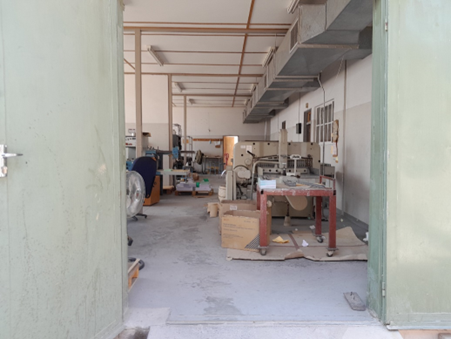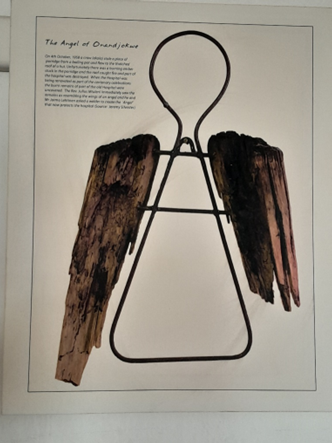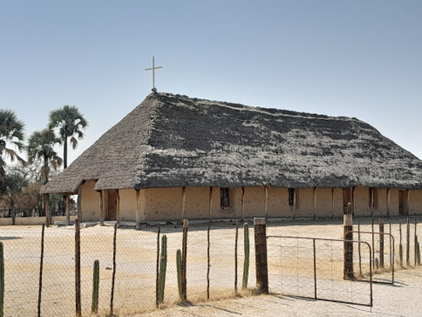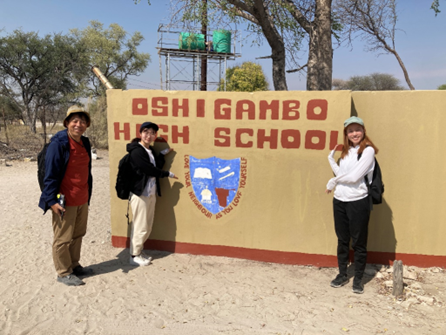Report on the Dispatch to Botswana, Namibia, and South Africa: Development of Scientific Research (S)
Kyoto University
Graduate School of Asian and African Area Studies
Professor, Akira Takada
From August 5 to 23, 2023, I visited mainly the National Archives and Library of Namibia, the University of Namibia, and the Evangelical Lutheran Church of Namibia, Oniipa, Oshikango High School, Eenhana to collect literature, hold research meetings, and gather data related to this project. This was a short visit to Namibia for me, about eight months after my visit to Namibia in November 2022, when Covid-19 was coming to calm down.
In Namibia, I first visited the National Archives and Library of Namibia in Windhoek, the capital city. The National Archives and Library of Namibia has the largest collection of documents and photographs in Namibia and is an extremely important institution for the researchers regarding Namibian in a wide range of fields including history, area studies, and anthropology. The materials are well organized, and the librarians have a deep empathy and understanding for research activities. During our visit, we were able to see the special collection of books, newspapers and magazines on Namibia and the collection of photographs taken during the colonial period in the basement, and gained valuable insights into the contact zones of African hunter-gatherers and agro-pastoralists in Namibia, the focus of this project. I was also able to purchase electronic versions of important photographs for use in our research.
Next, I visited the University of Namibia. In the Faculty of Sociology, our counterpart in Namibia. Over there, I had a meeting with Romie Nghitevelekwa, a lecturer specializing in land issues in Namibia and a collaborator in this research project, and collected data on the contact zones of hunter-gatherers and agro-pastoralists in Namibia. She is considering visiting Kyoto University as part of this project and conducting collaborative research in the field in Namibia.

After that, I moved to north-central Namibia, where I have been conducting research since I was a graduate student, and visited the Evangelical Lutheran Church of Namibia in Oniipa (Oniipa ELCIN). The ELCIN is a local association established in the 1950s through the great efforts of the Finnish Missionary Society (FMS) since the late 19th century. Oniipa has long been the headquarter of the society, which has not only a church, but also a library, a publishing house (ELCIN Printing Press & Book Depot; Photo 1), Onandjokwe Hospital (Photo 2), a guest house, and other facilities that have been established and operated in close relation with the church. We plan to continue our research on the ELCIN and the people who were involved in the movement, which spread from north-central Namibia and had a great impact on the founding of Namibia.
I also visited Olukonda, a 30-minute drive from Oniipa, where the first FMS station was established in the late 19th century, and where the FMS station is still preserved (Photo 3). The Nakambale Museum exhibits items related to Martti Rautanen (a.k.a. Nakambale), a Finnish missionary who contributed greatly to the missionary work of the FMS and the establishment of ELCIN, as well as materials on the local traditional culture. These exhibits reminded me of the history and culture of north-central Namibia, which has been undergoing rapid changes over the past 1.5 centuries, and of the people who have been involved in these changes.


I also visited Oshigambo High School (Photo 4), a prestigious high school in the region, and Eenhana, where the San (!Xun and ǂAkhoe) communities are located. Oshigambo High School is closely related to ELCIN and was an important educational institution that provided higher education for the residents of north-central Namibia since the colonial period. Many of its graduates have made significant contributions to Namibia’s independence and nation-building. During our visit, the principal personally guided us around the school. In the community of San in Eenhana, I conducted field research on the ecological future of child rearing among the !Xun. Although my stay was short, I was able to meet with old friends and acquaintances, as well as the youth and children of the following generation, and had valuable and heartwarming exchanges with them. Graduate students Ms. Mayu Watanabe and Ms. Mitsuki Kawajiri also participated.

After that, I visited the offices of the Red Cross Society and the Ministry of Information and Communication Technology in Eenhana and the town council in Oniipa, and held meetings with the staffs of these institutions and collected data on the contact zones of hunter-gatherers and agro-pastoralists in Namibia. Although it was only a short trip of a little over two weeks, I had a fulfilling time. I would like to thank the institutions and people who made this possible.
